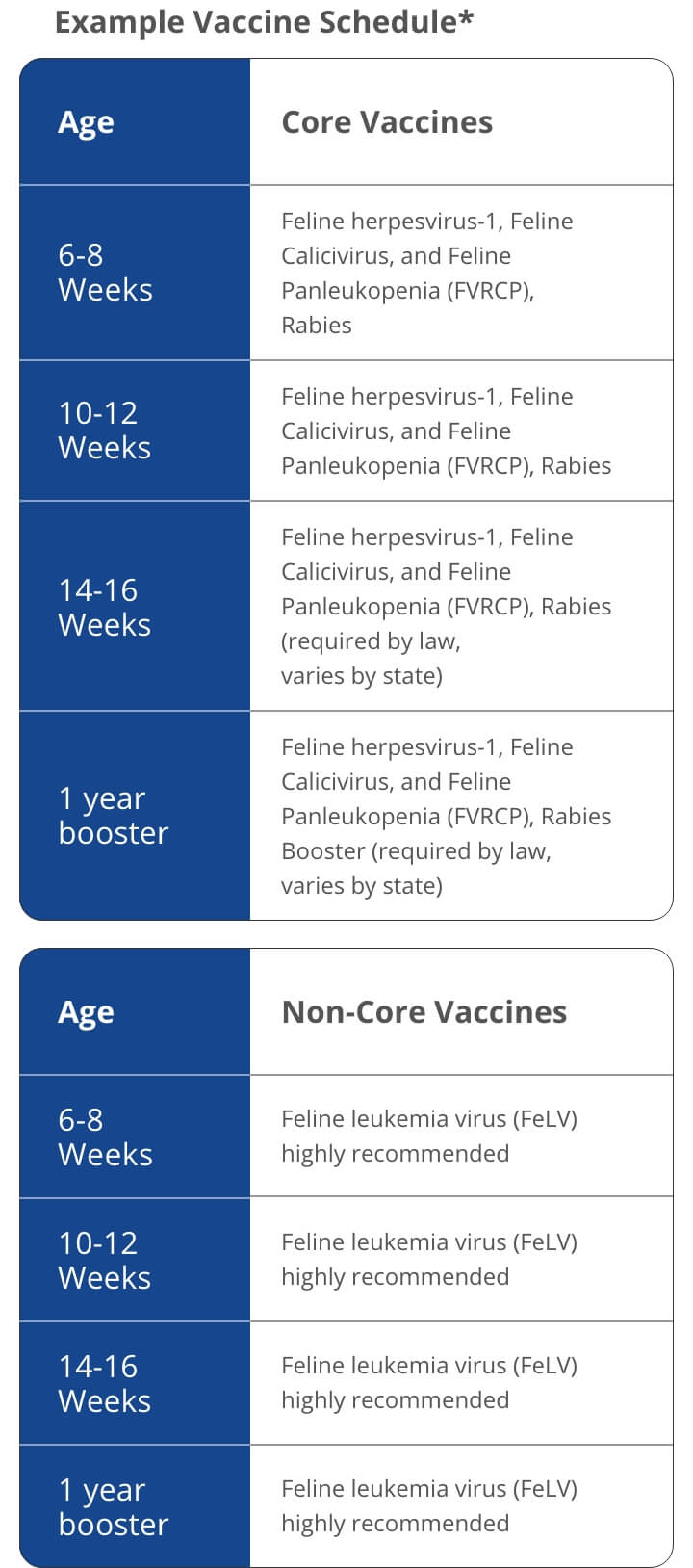
What Are Vaccines and How Do They Work in Cats?
Vaccines have the important job of helping to teach your cat’s immune system how to recognize and fight off disease-causing pathogens. They stimulate the immune system to produce antibodies that identify and destroy these pathogens and can minimize the severity of illness or even help prevent the disease altogether.
Vaccine schedules and recommendations are made by groups of experts such as the American Association of Feline Practitioners (AAFP) based on extensive review of the scientific literature and years of research and experience.
Core and Non-Core Vaccines
Core vaccines are recommended for all cats, regardless of age or lifestyle. Vaccines for feline panleukopenia virus (FPV), feline herpesvirus-1 (FHV-1), feline calicivirus (FCV), feline leukemia virus (FeLV) for cats less than 1 year of age, and rabies are all considered core vaccines.
Non-core vaccines are recommended for cats based on their exposure risk to specific diseases through lifestyle or geographic location. Vaccines for Bordetella bronchiseptica, Chlamydia felis, and FeLV for cats greater than 1 year of age are considered non-core vaccines.

Vaccine Schedule From Kitten to Adult Cat
Vaccines are the safest and most cost-effective way to help protect your cat from many preventable infectious diseases. Keeping them on a consistent vaccine schedule is important.

*Example vaccine schedule provided as general guideline. Actual vaccine schedules are tailored for the individual patient and vary greatly depending on a multitude of factors including individual pet lifestyle, geographic location, and veterinary preference. Please consult your veterinarian for all vaccine recommendations for your pet.
†Rabies vaccines are mandated by local law. Please consult your veterinarian for local mandates for rabies vaccines.

Feline Upper Respiratory Infection (URI)
Feline upper respiratory infection, also known as feline respiratory disease complex or FRDC, is a common illness in cats. It is similar to a cold but can be much more serious. A URI is caused by different viruses or bacteria including feline calicivirus, feline herpesvirus-1, and Chlamydia felis. Some common clinical signs include sneezing, congestion, runny nose, cough, nasal or eye discharge, fever, loss of appetite, and lethargy.
Feline URIs are extremely common. Most cats are exposed during their lifetime, and even with vaccination and proper treatment, they can reoccur. Brachycephalic (short-nosed or flat-faced) breeds such as Burmese and British shorthair cats are more susceptible to chronic disease.
Prevention
Vaccines for feline herpesvirus-1 (FHV-1)/feline viral rhinotracheitis (FVR) and feline calicivirus (FCV) are considered core vaccines and are recommended for cats regardless of age or lifestyle. Vaccines for FHV-1 and FCV are part of a combination core vaccine with feline panleukopenia. This is because all cats will be exposed during their lifetime, and the disease can be severe and even life-threatening in some cases. Vaccines for Chlamydia are considered non-core.

Feline Viral Rhinotracheitis (FVR)/Feline Herpes Virus (FHV-1)
Feline viral rhinotracheitis, also known as herpesvirus infection, is a highly contagious and infectious disease caused by feline herpesvirus type-1. FVR is a major cause of upper respiratory infections in cats. FVR primarily targets the respiratory system, causing symptoms such as sneezing, nasal discharge, conjunctivitis, and coughing. It can also cause ulcers on the tongue, lips, and cornea, leading to discomfort and difficulty eating. FVR can be transmitted through direct contact with infected cats or through contaminated food bowls or bedding.
Prevention
Vaccination against FVR is included in the standard core vaccines. As with any infectious disease, practicing good handwashing techniques after petting other cats and minimizing your cat’s contact with known infected cats will help minimize transmission.

Feline Calicivirus (FCV)
Feline calicivirus (FCV) is another virus that causes upper respiratory infections and oral disease in cats. Signs of FCV infection can include sneezing, nasal discharge, joint inflammation, and fever. In addition to these, cats with an FCV infection often develop ulcers on the tongue, hard palate, gums, lips, or nose. These cats will usually salivate or drool excessively as the ulcers can be very painful. FCV can be transmitted through direct contact with saliva or secretions from the nose or eyes from an infected cat or through contaminated objects.
Prevention
Standard core vaccines that are given to cats include immunization against calicivirus. Following good hygiene practices, such as washing your hands thoroughly before and after petting another cat, will help reduce the likelihood of spread.

Feline Panleukopenia Virus (FPV)
Feline panleukopenia virus, otherwise known as feline distemper, is a highly contagious, lifethreatening infectious disease in cats. It mostly affects kittens and unvaccinated cats, and it can be fatal if not appropriately diagnosed and treated. FPV infects and kills white blood cells, including cells in the bone marrow and intestines. Without these cells, the body is unable to fight off infection. Signs of FPV include vomiting, diarrhea, dehydration, weight loss, and fever. Even with extensive treatment, FPV can be fatal.
Prevention
Vaccination against FPV is an essential part of the core vaccine regimen for cats and is typically included in the standard kitten vaccination series. Keep your cat separated from cats with an unknown vaccine history, and practice good handwashing techniques after petting other cats.

Feline Leukemia Virus (FeLV)
Feline leukemia virus is a common disease that is spread from cat to cat and can lead to the destruction of the cat’s white blood cells and immune system. This leaves the cat more susceptible to infection, cancer, and death. Kittens and outdoor cats are especially vulnerable to FeLV. Transmission usually occurs through social behaviors such as grooming, licking, fighting, or other close contact such as sharing water and food bowls. When a cat is infected with feline leukemia virus, numerous types of infections, cancers, and blood-related illness such as anemia (low red blood cell count) can occur. The affected cat is unable to fight off infections, which could lead to a shorter life span. Signs of FeLV include weight loss, lethargy, poor coat condition, enlarged lymph nodes, recurrent infections, and gastrointestinal problems.
Prevention
You can reduce your cat’s risk of contracting feline leukemia with regular vaccination. The American Association of Feline Practitioners recommends the FeLV vaccine as core for all cats and kittens less than 1 year of age and then non-core for cats 1 year of age or older. Any adult cats with outdoor access or cats exposed to other cats with an unknown vaccination history should be annually vaccinated against FeLV.

Key Takeaways
Vaccinations are critical for the health and well-being of cats, as they help protect against potentially life-threatening diseases.
Many viral infections that can be prevented through vaccination, such as FVR, FCV, and FPV, can cause severe illness, chronic conditions, or even death.
Keeping a cat’s vaccinations up to date is a responsible way to help ensure their long-term health and reduce the risk of disease transmission to other animals.




